The Dentonian
Issue 38
Description of Cheadle
Cheadle nestles in agricultural moorland hills at the southern edge of
the Staffordshire Moorlands, about ten miles East of Stoke-on-Trent. It
is close to good road links with the rest of the country (M6 North - South,
and A50 East - West) and at Stoke sits on the West Coast Main Line of
the Rail infrastructure. It has a range of good, even (officially) excellent,
schools, ranging from nursery to sixth-form. There are extensive local
sporting and leisure activity clubs and resources, an established manufacturing
skills-pool, and a down-to-earth realism amongst its inhabitants.
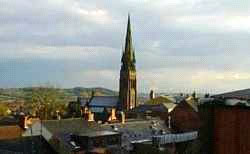 |
There are features of interest in Cheadle which make it merit a visit
on its own account, foremost of which is the magnificent Catholic Church
by Pugin whose 200 foot (61m) spire dominates the town. Its setting in
the hills and its proximity to both local (Croxton Abbey, Churnet and
Manifold Valley's), and national attractions (Alton Towers, the Potteries).
The origins of the name Cheadle are uncertain though appear to be based
in merchants, traders, or the practice of buying and selling. An excellent
account of the history of Cheadle appears in the 1881 book (reprinted
in modern times) by Robert Plant. The preface to his book puts an earthy
perspective on the town at that time, which remains largely true up to
modern times;
Some towns have derived their pretensions to a certain degree of celebrity
by reason of their antiquity; some from the enterprise of their inhabitants
in the past or present generations; and others, it would appear, from
the fact of their having been national rather than merely local. Perhaps Cheadle
cannot lay claim to notice on any of these grounds. It may not be so rich
in historic incidents as some places; and it may be thought that there
are few if any individuals who have belonged to the town whose biography
would be particularly entertaining.
Still it is not without a history; and as the seat of manufacturing industry, and the centre of a large agricultural district, and of a great extent of mining field, it is not altogether devoid of interest to those who desire to possess local records
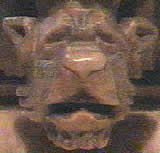
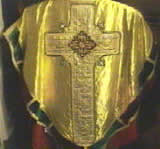
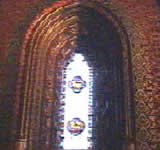

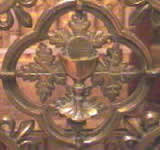
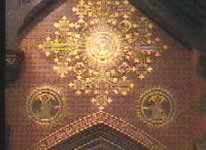
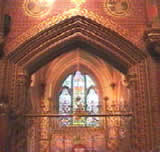
Robert Plant 1881
The towns’ prosperity had clearly fluctuated up to that time, and
the basis of its economy was diverse. Agriculture (arable and livestock),
manufacturing (brass, silk, tape, fabrics) and mining (stone and coal)
have all featured to greater or lesser extents in the towns history.
Since then, the agricultural trading use has subsided, the mines have
all closed, and the manufacturing fortunes have fluctuated. Today, manufacturing
and local trading are the mainstays of the town. The largest single private
employer is JCB, having new factories on the outskirts of the town supplementing
their other facilities in the district.
Conservation
Despite Robert Plant's comments, Cheadle is a town with plenty of heritage
to be proud of. The buildings in the town are a prime example. Like so
many towns, development has led to the sad decline or loss of many fine
properties or structures. One scheme currently operating which couold
assist this process in Cheadle is the "Cheadle Conservation Area
Partnership Scheme"
There are some delightful architectural examples in the town, though many
it has to be said are sadly neglected. Reference has already been made
to the magnificent Catholic Church known as "Pugins Gem". The
Georgian Market Square is picturesque though dilapidated. Harewood Hall,
Thornbury Hall and Hales Hall are examples of fine country manor houses
and there are many fine farm-houses.
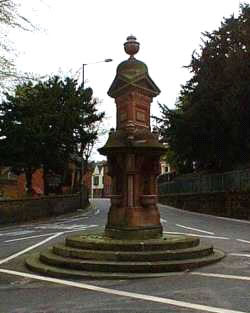 |
Monument
|
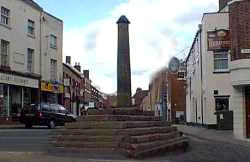 |
Market Cross
|
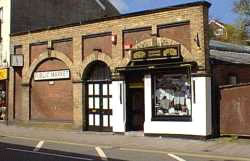 |
Market Hall
|
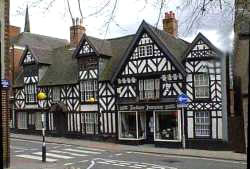 |
Tudor House
|
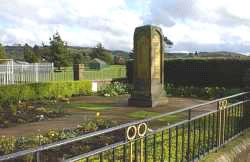 |
War Memorial
|
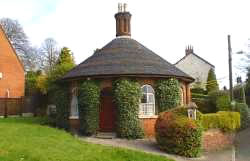 |
Round House
|
Genealogy
A surprisingly large number of inquiries about areas in the UK are
from people overseas investigating their possible roots in this country.
Thanks to the personal interest and generosity of a great many volunteers,
and with remarkable organisation, it is possible to investigate
a great deal using links over the Internet.
Specific to Staffordshire there is the site which is focused on the county
www.genuki.org.uk/big/eng/STS/.
Specific to Cheadle there is a further site
www.genuki.org.uk/big/eng/STS/Cheadle/index.html#ChurchHistory which describes
much about the towns history and offers links to more specific inquiries.
One particularly interesting avenue of investigation arises if you ever had a Doctor in the family. the site at http://user.itl.net/~glen/doctors.html explains all about how to trace their history.
St. Giles', Cheadle.
This church was begun in 1840 and completed in 1846. The six years it took to create this splendid building exhausted Pugin and damaged his health. It also drained the Earl of Shrewsbury's coffers severely. However their friendship remained intact.
Cheadle perfect Cheadle'
On walking into this church I was rendered speechless it is a truly fabulous
and elaborate work of art. Pugin was known to have said ‘Cheadle
perfect Cheadle, my consolation in all my afflictions'.
I was privileged to attend mass on a Sunday morning, the church was in
candlelight and it was a wonderful site'.
Decoration
Virtually every single part of the church is decorated from the floor to the ceiling, the stonework is painted, the walls are decorated, the floor is tiled. The rood screen is of brass and gilded wood.
Collaboration
Pugin’s team all had a hand in completing this stunning extravaganza.
There is metalwork by Hardman, stained glass by Wailes. Wall paintings
by Crace, tiles manufactured by Minton. Myers, handled the most intricate
carving of stonework, including the figures of St. Peter and St. Paul.
An architectual sculpture called Roddis was also responsible for much
of the interior detail.
Myers was bought in late for the project, because the Earl of Shrewsbury
wanted the local tradesmen and craftsmen to benefit from the building
of their local church.
The font is like the one in St. Augustine’s, Ramsgate with a rising
and falling perpendicular top, and it is heavily carved on the base.
Outside the Church
The exterior of the church is built of local red sandstone with a lot of carved faces. The roofs are steep with cast iron crestings. The west doors are red with huge Talbot lions standing facing one another, with carved stone arches surrounding them. Pugin also had the gateway and the churchyard wall built.
An Archaeological Evaluation of St Lawrence's Churchyard, Denton
Background to the Project
The greater part of St Lawrence's churchyard is under the management of
Tameside MBC with a small part retained under the control of the church
as a garden of remembrance.
The church is currently undergoing the third of a three stage historical
restoration scheme and the Council is implementing a scheme to restore
the churchyard and provide an appropriate setting for the Grade II* Listed
Building.
The Churchyard Restoration Scheme
The restoration scheme for the churchyard will focus on the repair and
restoration of the key elements which contribute to the setting of the
Church whilst considering how the introduction of new or redesigned features
could address the following needs: -
To provide an appropriate setting for the Church as a Grade II* Listed
Building
To provide an appropriate setting for a garden of remembrance
To re-establish a safe and attractive "Sitting-in-Park" for
the local and wider communities, and
To consider the role of adjacent parcels of land within the setting of
a Grade II* Listed Building.
The restoration of the churchyard will be based on a comprehensive understanding
of the site and its history. The restoration scheme consisting of proposals
for implementation, maintenance and management will be relatively simple
and bold in design but of a high quality appropriate to this situation.
Historical research into St Lawrence's has uncovered considerable information
relating to the history and development of the Church and the Churchyard.
Contrary to initial thoughts it appears that the churchyard has increased
in size over the years as opposed being a large churchyard that has been
eaten into by neighbouring developments. Research shows that, in close
proximity to the church, there was a Chapel House, School and a building
called the "Old Thatch".
An archaeological evaluation scheme has been developed in consultation
with the University of Manchester Archaeological Unit to uncover evidence
of any historical remains which may exist within the churchyard. The findings
will influence the development of the restoration scheme.
The Archaeological Evaluation Scheme
In order to assist with further historical analysis of St Lawrence's Churchyard
and to influence its appropriate restoration UMAU will research the following
:-
1.The course of old drains through the grave yard
2.The extent and character of vaults and grave cuts
3.The depth of topsoil above human remains
4.The extent of remains of previous buildings within the curtilage of
the Church.
The archaeological evaluation will take the form of trial trenching to
provide information on the above. The trenches will be 1m wide and will
be excavated down to the top of intact human remains, burial vaults, old
drain channels or foundations of the former buildings. A plan is attached
showing the location for these trenches and the rationale is set out below:-
Trench A — to examine evidence for the "Chapel House",
old drains and vaults/graves.
Trench B — to evaluate the impact of any restoration proposals
on burials
Trench C — to evaluate the depth of sensitive deposits where future
works are close to trees
Trench D — to verify the existence of a vault
Trench E — to check for remains of the "Old Thatch" and
burials
Trench F — to check for remains of the "School" and burials
Trench G - to examine evidence for old drains and vaults/graves
Timescale
The evaluation works will start on site in April 2004 and will involve a team of four archaeologists, led by John Roberts, on site for two weeks to undertake the hand digging down to the top of the archaeology and the subsequent recording. The report on findings will be produced for the end of May 2004 and any finds will be incorporated into the next Tameside monograph which is the St Lawrence's volume and programmed to be published in Autumn 2004.
N.B. Work on this project started on April 19th - we hope to have a group
visit during the 2nd week
Final Installment of the Hallsworth family memories.
(courtesy of Valerie Blease)
I well remember Grandad. He was short of stature, a round tubby man, fond
of a joke and one who would play practical jokes. When I think back, I
can now see how he tried to encourage me to read poetry and when he saw
that I had an interest in the same, he would leave a book of poems open
for me to pick up and get interested in. A big interest was the Trinity
Wesleyan Church on Hyde Road and he attended both services on Sundays.
After the morning service he would sometimes walk down to our house in
Nield Road. He was in office as a steward for many years and on the occasion
of the Sermons in May, this would be the big day. Aunt Tillie and Uncle
Dick would come over from Farnworth and all the family would go to all
the three services; and my parents and myself would go to High Tea. I
cannot say that I enjoyed them, for a small boy to have to go to church
three times in a crowded atmosphere on a hot May Day was not to my liking.
However it was nice to meet the relatives who lived away.
My Grandad had a brother Henry who lived at Hyde; I only met him once
or twice and being entirely different in nature than Grandad, I don't
think they bothered about each other. I may be wrong. The tragic thing
about him was that in his late years he threw himself under a train.
The Great War from 1914 to 1918 carried on and the loss of life was tremendous,
but I don't think it made any difference to my Grandparents business.
People who worked in munitions earned good wages and it was in their mind
if the war should be lost, gold articles would hold their value, so the
business prospered. Auntie Annie once told me that the watch repairs increased
also but Grandad was not allowed to serve at the counter because if the
customer were poorly dressed, he would not charge enough for the repair.
This just goes to show what sort of man he was.
My dear Grandma was now crippled with arthritis and her knee joints had
seized up but it did not stop her from serving in the shop. I well remember
her and although she could be very strict, I could always get round her
for sweets etc. I am sorry to say she spoiled me a little. No doubt much
of their success was due to her, for she would get all the meals, serve
in the shop and she attended to the wants of her three children.
My father told me many tales about her and himself. One such is when father, a little boy, came in all wet through, his clothes all saturated. He was duly given punishment and sent to bed. It was not long after that the parents of a small boy came to the shop wanting to thank young Harry for saving the life of their son. It seems father had jumped in the local pond and brought out the little boy when he had fallen in. Father had come home and had not let him explain. However he was duly told to get dressed and Grandma expressed how sorry she was that she had punished him so, and no doubt rewarded him with a large piece of custard.
Grandfather continued during the war years with his business, for although he had intended to build five shops, with the war he was only able to complete three — his own which was at the Crown Point corner and two others on Ashton Road. These other two were let to the Maypole Dairy Co Ltd and the other to a Baker. I just remember the other two shops standing there uncompleted, the brickwork showing stark against the outline of Ashton Road. These must have been very troublesome times; the toll of human life began to tell. One incident I was told shows the nature of my Grandfather.
Miss Nelly France is now an old gentle lady and she told me of when the news came through that one of her two brothers had been killed in France. Several days later, Grandad received the news via the telephone that the second son had also been killed. He then closed the shop and went all the way to Oldham to convey the news to Miss France's father of his loss.
The Denton of that day is much different from our present time and it was now necessary to move to get more space and so the exchange was moved to 8 Hyde Road and Auntie became supervisor with the help of a young girl who is now Mrs Alfred Brown of Haughton Green.
My other Aunt, my Grandparents' youngest daughter, served in the shop. Auntie Clara I have no memory of her for she died when I was four years old, being a victim of the influenza epidemic of 1918. This was a sad loss to the family. It was just before the Christmas of that year and it must have been rather sudden, for she bought me a rocking horse in Manchester, bringing it home with her on the tram. Grandma said it was bigger than she, but she insisted on bringing it home. Alas she never saw me play with it and it must have been very sad when on Christmas day I took possession of the same.
Another part of Grandfather's work was to see to some of the local Church clocks and every week he would wind up the big weights that kept the clocks in motion. To go with him was quite an adventure for this meant climbing into the church tower. This was done by means of a tall ladder at St Stephens Audenshaw and he made me climb up with him following. Another time at Christ Church Denton, he took me further up the clock, partly up inside the steeple, to see the view over the local countryside.
After the Great War, the other two shops were completed and tenants readily took them, being in the centre of the town. I attended the local council school and on the way home I would call to see my Grandparents and Auntie, and I'm afraid I was rather spoiled by them. Grandfather made me a rather large engine, which I played with around Crown Point. I wonder what the pedestrians would do now if a small boy came charging down Manchester Road with an engine! He also made me a real steam engine and with a boiler which was heated by gas. I was not allowed to use it much for mother did not like the use of the gas, also the expense.
The Crown Point of that day was much different to today. The old Red Lion Hotel stood on the corner of Hyde Road and Stockport Road and on the Ashton Road corner was a Newsagent's shop — very dingy and ill lit. These of course have been replaced by a bank and a new public house.
I well remember it now, for until I was fourteen, I had to assist Grandad in the shop from four o'clock till six o'clock five nights a week, for which I was paid one shilling. I'm afraid I did not care for it very much but I now realise how good it was for me for my duties were: cleaning clocks in the cellar and putting optical lenses in their proper places in a box after their use. But on a summer's evening when all my pals were playing out I longed to be with them.
My Grandparents became friends with several of the people of Denton who had much to do with the beginnings of this town in making it grow from a village. Just to name a few — the Claytons, who came to Denton and were printers and had one of the first cars in the town. They had a shop on Ashton Road, where the Trustee Bank now stands and they also served petrol right into the main road from a pump built on to the pavement.
Another feature of Crown Point was the clock which stood over the entrance of Grandad's shop. This I believe was one of the first electric clocks in the district and it was a recognised place to meet and it was known as Hallsworth's Clock. And many here, (boys and girls) made it their meeting place, later to buy their engagement rings and later still the wedding ring. The strange thing about this clock was that on Grandad's retirement to Blackpool, it never again kept the time which it was noted for and in due time it was taken down.
Grandad began to feel the strain of business and they decided to retire to Bispham, Blackpool and a bungalow was acquired. The bungalow was duly named, 'Crown Point' after their abode in Denton. It was about 1929 when they made their move and it coincided with one of the worst storms in living memory. The main part of Fleetwood was under water and several buildings had their roofs ripped off.
My Grandad sent word for me to go to see the damage and I well remember seeing a Mission Church all collapsed and the concrete promenades all smashed up. My Aunt told me that on that night she was afraid and she went to my Grandparents' bedroom only to be told she would have to get used to it for the heavy winds were common on the sea coast. The next morning, she said, part of the roof was missing showing that this was indeed not a common gale.
All my school holidays were spent there and Grandad went out of his way to entertain me, taking me on long walks. We would do the walk from Bispham to Fleetwood, coming back on the tram and then sometimes to Pilling, there to have tea before walking back through the fields.
I was expected to go to the Bispham Methodist Church which my Grandfather
had joined when they moved. This I did not care for but I was made to
go. Grandad on his retirement tried to take up gardening but it was not
his line and he soon fixed up his watchmaker's bench and was soon as busy
as ever.
It was very sad for me when it was discovered that his health began to
fail. He began to lose weight and the worst came when he took to his bed
a victim of cancer. His last words to me were to look after Auntie Annie
and he then said to my Grandma that he would wait for her to come to him.
Such was their faith. He was duly interred at Denton, that being his wish.
Grandma survived him by several years and Auntie Annie looked after her.
She took her out in a wheelchair, pushing her along the proms —
much against the doctor's orders who had seen her little figure pushing
the chair.
After Grandma's death, Auntie lived there alone and she became really
active in the Methodist church, taking part in concerts etc.
She lived there all through the war years. On one occasion she found a
burglar in her house and she tackled him on her own. Fortunately for her,
he ran out of the house. This had a marked affect on her and she was never
really the same after this and she decided to move back to Denton. She
purchased a house on Bentley Road to be near my father. She died in 1950
aged 67.
The Hallsworth file and other related material, family papers etc, can
be accessed in the archive,
Toffee Nostalgia
I can remember the days long before Z-bars, when we had Tommy Todd rock and real Kendal Mints. Toffees look like Kendal Mints but that taste is not there. Then many toffees are not what they look like these days, I can remember when chocolate was chocolate, not that plastic stuff as Cadburys would have us believe is the same as it used to be.
Just take a Milk Flake and brake it, in half, nothing to it you say. Well, now the old original Flake if you tried to break it or dropped it on the floor it shattered into a million pieces, as to the taste. Well that is long gone with progress and profit, being more important than the genuine article.
Real toffee used to be made on Hyde Market by "Nightingales." (They had two shops in the town.) They made Godley Rock, Mint Rock, Clove Drops, Aniseed Drops, Cough Drops, Cough Candy, Mint Candy, Treacle Toffee, Nut Brittle, and a host of other toffees.
The smell of all this used to fill the air on a Saturday night up to 10 o'clock that was the time he packed up. You might still get some toffees that go under some of the above names, but that smell and all those tastes are long gone with old Nightingale and his Primus stove.
Taste and try before you buy, you cannot buy better, home made treacle toffee, was his cry. He just used sugar, butter, and the genuine oils. The day of the industrial chemist had yet to come.